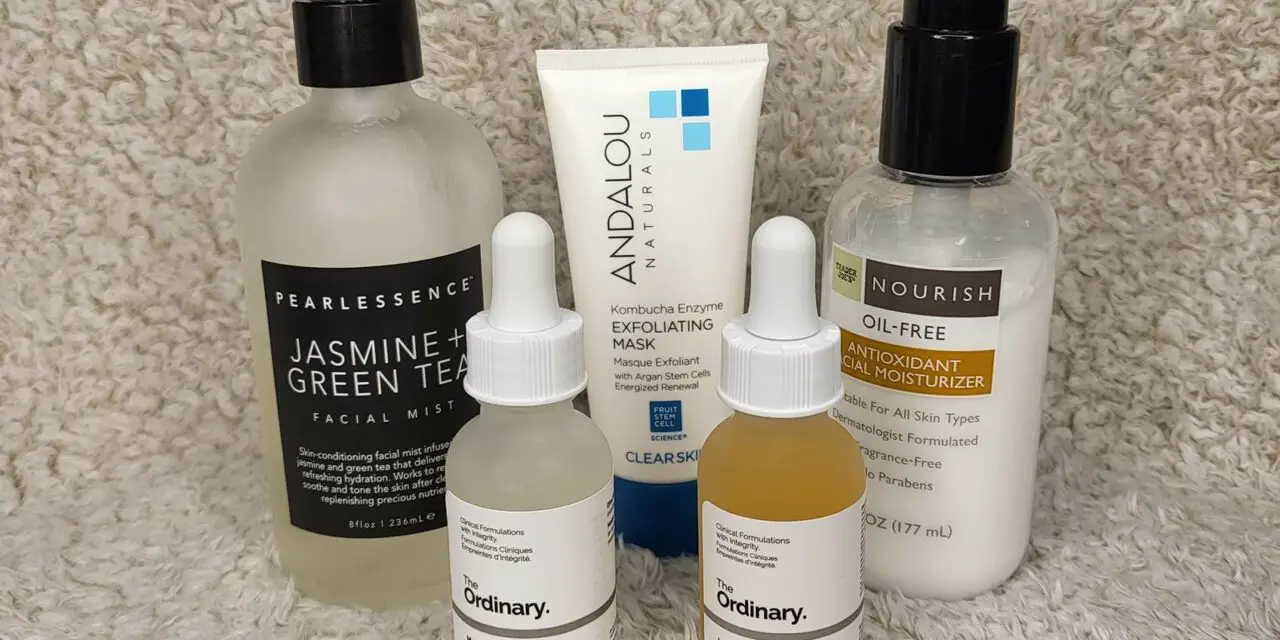Peptides are short chains of amino acids, which are the building blocks of proteins. They are molecular in size. Many kinds of peptides naturally exist in our bodies to send signals to different types of cells. Some are precursors to hormones like insulin and oxytocin. Others play vital roles in the immune system. They even assist in wound healing, and those mechanisms have been harnessed for use in anti-aging skin care.
Types of peptides in skin care products
Most peptides used in skin care stimulate collagen and elastin production in the skin. Collagen, a protein that gives skin its strength, is involved in scar formation and wound healing.
Elastin gives skin elasticity, or the ability for it to bounce back quickly after being pinched or indented. Both collagen and elastin are abundant when we are young. Production naturally diminishes as we get older; sun exposure and skin inflammation destroy them.
Cosmeceutical peptides are usually patented, and research tends to be limited to the manufacturer. Because of this, it’s difficult to know the details of the studies, like the methods used. Sample sizes are small and unvaried, and studies are not always done in-vivo.
However, you can find some basic information about them in cosmetic ingredient dictionaries. The names of individual peptides refer to the number of bonds in its molecular structure.
The following are some commonly used peptides and their functions in skin care products.
- Tridecapeptide-1 (BGT™ TDP-1) is used as a skin conditioning agent. This is a commonly used peptide.
- Palmitoyl Dipeptide (Matrixyl™) stimulates production of collagen and laminin in the skin. Laminin is an important protein that helps keep the structural integrity in the deeper layers of the skin, where regeneration occurs.
- Sh-polypeptide-121 (HumaColl21®) was originally derived from e. Coli bacteria, but is now created from vegan methods for skin care use. This peptide increases collagen xxi (21), which is the type of collagen that keeps the cells in the dermis, or deepest layer of the skin, healthy. This is important because this layer contains the substances that keep our skin plump and youthful.
- Palmitoyl Tripeptide-38 (MATRIXYL® synthe’6) is a powerful peptide that increases three types of collagen in the skin, as well as one hydrator and two proteins involved in wound healing.
- Tetrapeptide-72 (Skinarch™), also known as Palmitoyl Tripeptide-72, increases the types of collagen that act as scaffolding to hold up the structure of the skin, keeping it firm.
- Palmitoyl Hexapeptide-12 (Biopeptide El™) is naturally found in elastin. In a skin care product, it serves to increase elasticity and keep the skin supple.
- Palmitoyl Tripeptide-5 (SYN®-COLL), a popular peptide, is marketed as a booster of collagen production.
These ingredient names are certainly a mouthful, and they might look a little scary. Ingredients that are hard to pronounce are not necessarily harmful chemicals. For example, the technical name for water is dihydrogen monoxide.
When you’re choosing skin care products, it’s helpful to understand what some of these ingredients are so you know what to look for. Sometimes their names will contain clues as to their origins.
For example, palmitoyl is a substance derived from palmitic oil, which is found in most vegetable oils, including palm oil. Many skin care ingredients come from nature, and they’re modified so they can boost the efficiency of another ingredient. Palmitic acid is modified and attached to the peptide so that it can penetrate the skin’s surface.
How to choose the best skin care product
You can begin your search by entering “peptides for” in your search engine and following with your main skin concern (like wrinkles or acne). Include your skin type (oily, dry, combination, sensitive) to narrow your results. Look through the customer reviews and decide on your budget. Since skin can be finicky, try to shop from places that allow returns.
You can also consult with an esthetician or a sales associate at a beauty store like Sephora.
Here are five popular picks to check out:
1. The Ordinary “Buffet” Multi-Technology Peptide Serum
Best budget-friendly product. This is a top-selling lightweight serum that complements any skin care routine and is great for all skin types.
Active ingredients: Acetyl Hexapeptide-8, Pentapeptide-18, Palmitoyl Tripeptide-1, Palmitoyl Tetrapeptide-7, Palmitoyl Tripeptide-38, Dipeptide Diaminobutyroyl Benzylamide Diacetate, Acetylarginyltryptophyl Diphenylglycine.
Pros: Good for oily skin.
Cons: Can feel sticky once it starts to dry on the skin.
2. Glo Skin Beauty Bio-Renew EGF Drops
Best for mature skin with moderate signs of aging. This luxurious serum contains four different peptides aimed at helping your skin renew itself from within. It can be layered underneath your favorite moisturizer or sunscreen.
Key ingredients: N-Prolyl Palmitoyl Tripeptide-56 Acetate, sh-Oligopeptide-1, Acetyl Hexapeptide-49, Pentapeptide-48.
Pros: Good for sensitive skin, since it’s free of dyes, fragrances, and other common irritants.
Cons: At $130, it is a more expensive option.
3. Biossance Squalane + Copper Peptide Rapid Plumping Serum
Best for all skin types, including sensitive skin. This multitasking serum provides copper peptides while increasing your skin’s ability to retain water.
Key ingredients: Tetrapeptide-30, Palmitoyl Hexapeptide-52, Copper PCA.
Pros: Lightweight formula that doesn’t get sticky; fragrance-free.
Cons: Small chance of irritation from botanical ingredients.
4. Dermalogica MultiVitamin Power Recovery Masque
Best for skin showing any degree of aging. Rich and creamy, this mask can be used once a week to complement your skin care routine. A little goes a long way with this concentrated formula, and it’s great for anyone that has mild to advanced signs of photoaging.
Key ingredients: Palmitoyl Tripeptide-1, Palmitoyl Tetrapeptide-7.
Pros: Moisturizing and soothing.
Cons: Can irritate sensitive skin or cause clogged pores if you’re prone to them.
5. Tree of Life Matrixyl 3000 Anti-Aging Face Cream | Advanced Moisturizer with Polypeptides
Best for dry skin
Besides being packed with collagen-boosting peptides, this cream contains shea butter, which moisturizes and protects dry skin. Since its texture is rich, it’s best used as a night cream.
Key ingredients: Palmitoyl Tripeptide-1, Palmitoyl Tetrapeptide-7.
Pros: Moisturizing for dry and mature skin.
Cons: Contains peppermint extract, which can irritate sensitive skin.
What are copper peptides and retinol that I see in skin care products?
Copper peptides and retinol are included in skin care products as anti-aging ingredients. Copper peptides stimulate the production of collagen and elastin, which keep the skin firm.
Retinol boosts the skin’s natural exfoliation process. Over time, this leads to a smoother texture. Both copper peptides and retinol are usually added to products that are meant to stay on the skin, and not washed off, like creams and serums.
Copper peptides
Copper peptide, also known as Glycyl-L-histidyl-L-lysine (GHK), was extracted from human plasma in 1979. GHK has a strong affinity for copper and binds to it, creating Copper-GHK, a peptide that is known for its role in wound healing and tissue repair.
Collagen is a fiber produced by cells called fibroblasts. Fibroblasts use copper in the formation of collagen. GHK binds to copper and acts as a “carrier” peptide, delivering the trace element to fibroblasts. Regular use of copper peptides leads to stronger, firmer skin.
There are a few drawbacks to copper peptides. They may irritate sensitive skin and rosacea. They may also cause an allergic reaction in some people.
Retinol
Retinol and retinoids are often used interchangeably, but they mean different things. Retinol is also known as vitamin A. Retinoids are chemical compounds derived from vitamin A that have regenerative properties when applied to the skin. Retinoids are commonly used for their anti-aging purposes and to treat acne. It works by normalizing the skin’s natural exfoliation process and reducing inflammation.
Prescription-strength retinoids are also available to treat signs of skin aging, also known as photoaging. This refers to the effect that long-term exposure to the sun’s ultraviolet (UV) rays have on the skin: wrinkles, rough texture, laxity, and uneven tone.
The retinoids you find in over-the-counter are not as potent, so the side effects will be more tolerable but the results won’t be as dramatic. These retinoids are suitable if you’re concerned with early signs of photoaging, which usually begin to show in your 30s. They can also maintain skin health after you’ve finished a course of prescription retinoids.
In addition to using retinoids, it’s crucial to use sunscreen every day and limit your sun exposure. Retinoids exfoliate the skin, making it more susceptible to UV damage. Not only will you burn more easily, your risk of skin cancer increases if you leave your skin unprotected. UV damage will also cause additional photoaging, which is counterproductive.
What is the best strength of retinol to use?
If you’re eager to get fast results, you might be tempted to jump in by starting off with the highest concentration you can find (usually 1%). This could end up causing skin irritation and excessive peeling, and that’s the main reason people get discouraged and stop using retinoids.
Instead, find a low dose, such as .2%, and begin by applying it daily. Once you’ve used up that product, go up to .5% and repeat the process. This lets your skin acclimate until you are ready to “graduate” to 1%.
How to apply retinol on my skin?
- After cleansing and drying your skin in the evening, apply no more than a pea-sized amount to the palm of one hand. Use the fingers of your other hand to dot it onto your forehead, cheeks, and chin.
- Use your fingers to spread the product.
- Because retinoids can be drying, use a moisturizer. Wait at least one minute for the retinol to absorb before applying it.
Do not use retinoids if you are pregnant or have skin irritation.
How peptides work to benefit your skin
Many peptides used in skin care are “signal” peptides. They act as messengers to stimulate production of substances that make up healthy skin, such as collagen and elastin.
Another category of peptides are enzyme inhibitor peptides, which reduce the presence of the enzymes collagenase and elastase. These enzymes are released when the skin is inflamed or injured, and as their names suggest (-ase), they destroy collagen and elastin.
A third category is antimicrobial peptides, which is used to fight acne. Acne is caused by overgrowth of the bacteria Cutibacterium acnes that live in our follicles.
Let’s take a closer look at how peptides work to clear breakouts, reduce wrinkles, and improve skin defense.
Clear breakouts
Our skin is a microbiome, and one of the bacteria that resides in our follicles is called Cutibacterium acnes (C. acnes), formerly known as Propionibacterium acnes (P. acnes).
These bacteria becomes a problem when our follicles, or pores, become clogged and filled with dead skin cells and sebum (oil). Cut off from oxygen, this creates a breeding ground for the anaerobic C. acnes.
For most cases of acne, dermatologists prescribe antibiotics like erythromycin and clindamycin. There’s growing concern over antibiotic resistance to these widely prescribed drugs. An common over-the-counter treatment is benzoyl peroxide, which can be irritating and drying.
Isotretinoin, a strong oral form of retinol, comes with severe side effects. The battle against acne can be frustrating and come with collateral skin damage.
Antimicrobial peptides, or AMPs, offer a new option. Unlike antibiotics, these peptides work by influencing the skin’s immune response to C. acnes.
Antimicrobial peptides have been shown to fight acne by reducing inflammatory activity caused by infection in the follicles.
A 2013 study used an AMP called LZ1 on acne that was colonized in the mice of the ears. In vitro, three C. acnes strains were tested, including one that was resistant to Clindamycin. LZ1 showed antimicrobial activity with all three strains. It also decreased inflammation in the mice’s ears.
Copper peptides reduce inflammation and improve the skin’s healing process, also known as tissue-remodeling. This process uses collagen, which copper peptides help produce.
Reduce wrinkles
Fibroblasts are cells in the skin that produce collagen. Think of them as tiny factories “blasting” out collagen fibers. As we age, their output decreases. This leads to the skin structurally becoming weak and collapsing, resulting in wrinkles. Peptides send signals to the fibroblasts to get back to work. Collagen fibers act as a support structure for the skin, and the stronger that structure is, the more firm and smooth it will appear.
Improve skin defense
Our skin is our body’s first line of defense against infectious disease. It acts as a barrier to keep harmful invaders out. This barrier is strongest when it’s intact—free of wounds and inflammation.
Copper peptides are known for their role in wound-healing. They’ve been shown to increase the production of collagen, the protein that’s key to skin repair. They also regulate certain enzymes that are released during the wound repair process. These enzymes, called proteases, break down proteins that are necessary for skin strength. Copper peptides are also antioxidants, which help the skin recover from the damage caused by UV exposure from the sun.
Are peptides safe?
Peptides are generally safe and well-tolerated by most people. However, peptide products can aggravate skin that’s already irritated. If you have a condition like eczema or psoriasis, you should consult with a dermatologist before trying out peptides.
Should you use skin peptides with massage products?
Skin peptides could, in theory, be used with massage products. A peptide serum could be layered underneath a massage lotion, cream, oil, or gel. It would be expensive to use a peptide product all over the body, and it’s best to limit the peptide use to one area.
Cosmeceuticals are more effective on a clean slate and will penetrate more effectively on skin that has been cleansed and is bare. For parts of the body that have thicker skin, you’ll need to exfoliate first for peptides to work. Peptides show the best results with daily use. A single application with a massage might make the skin feel more hydrated, because of the lubricating carrier ingredients in the product, but it won’t make a noticeable difference in any other way.
However, using peptides in a massage service could be a great way to retail peptide products by allowing a customer to sample them.

Raquel Wong, LMT, LME
Raquel Victoria Wong is a licensed master esthetician, cosmetologist, instructor, and massage therapist. She began in the beauty field, studying at Eric Fisher Academy in her hometown of Wichita KS. As an instructor, she was nationally recognized with an award for “Excellence in Esthetics Education.” After attending Northwest Academy for the Healing Arts in Seattle, Wash., she transitioned into a career in massage, which she practices today. She is currently working on a bachelor’s in Health and Human Services. Raquel speaks Spanish and is an artist in her free time, drawing portraits of people and pets.






